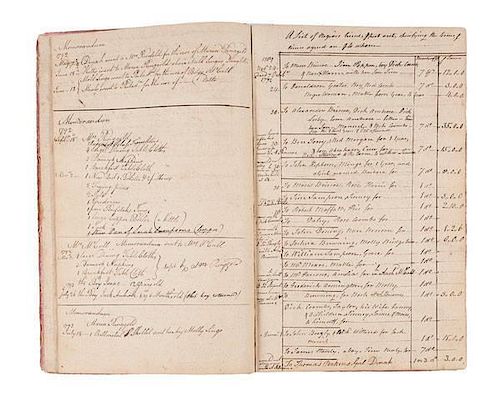Revolutionary War General John Cadwalader, Bound Manuscript Journal Kept by Executors of his Estate, Including References to Slaves
About Seller
6270 Este Ave.
Cincinnati , OH 45232
United States
With offices in Cincinnati, Cleveland and Denver, Cowan’s holds over 40 auctions each year, with annual sales exceeding $16M. We reach buyers around the globe, and take pride in our reputation for integrity, customer service and great results. A full-service house, Cowan’s Auctions specializes in Am...Read more
Two ways to bid:
- Leave a max absentee bid and the platform will bid on your behalf up to your maximum bid during the live auction.
- Bid live during the auction and your bids will be submitted real-time to the auctioneer.
Bid Increments
| Price | Bid Increment |
|---|---|
| $0 | $25 |
| $500 | $50 |
| $1,000 | $100 |
| $2,000 | $250 |
| $5,000 | $500 |
| $10,000 | $1,000 |
| $20,000 | $2,500 |
| $50,000 | $5,000 |
| $100,000 | $10,000 |
About Auction
Jun 13, 2014 - Jun 14, 2014
Cowan's Auctions dawnie@cowans.com
- Lot Description
53pp and 61pp in two sections (some page in each section blank).
Though born into one of the wealthiest Quaker families in Trenton, NJ, the career of John Cadwalader (1742-1786) seems hardly Quakerly at all. Highly successful as a merchant in the 1760s, Cadwalader became an early and ardent convert to the revolutionary cause and by 1776 he was counted as a staunch member of the Philadelphia Committee of Safety and a Captain in the famed "Silk Stocking" City Troop, earning a commission as Colonel in the Pennsylvania militia. Commanding Pennsylvania troops during the winter campaign of 1776-1777, Cadwalader was not notoriously effective: he was thwarted in his attempt to provide effective support for Washington's attack on Trenton (the Delaware River crossing) and he saw much of his untested command fall out in disarray and ignominious retreat at Princeton. After raising militia on the Eastern Shore of Maryland, Cadwalader took part in the battles at Brandywine, Germantown, and Monmouth. Twice declining commissions as Brigadier General, Cadwalader carried one distinction from his military career for the rest of his life: in a notorious duel with Gen. Thomas Conway in 1778, he grievously wounded the man implicated in a serious "cabal" to oust George Washington from his command of the Continental Army. Cadwalader retired to his lavish estate, Shrewsbury Farm, in Kent County, MD, where he was noted as a breeder of high quality horses. He died on Feb. 10, 1786, but his family legacy is still felt in the decorative arts community: several examples of the high-style Chippendale furniture he commissioned from the greatest cabinetmakers of the mid-Atlantic region have become keys to the collections of museums from the Metropolitan Museum of Art, the Philadelphia Museum of Art, and Wintherthur.
This impressive ledger documenting the administration of John Cadwalader's estate is maintained in two dos a dos sections, one entitled Book of memorandums, inventories, and miscellaneous transactions of the Exter [Executor] to the estate of John Cadwalader, Esqr (begun March 1786), and the second untitled section consisting of memoranda and receipts by the estate begun Nov. 1790. Both deal largely with the administration of Shrewsbury Farm, with references to other Cadwalader holdings. Admittedly, administrative records are not known as stirring bedtime reading, but Cadwalader's is a stunning exception, sketching out the material lives of Pennsylvania's elite during the early Republic and contributing important information to the history of decorative arts, horse culture, and to the persistence of legal slavery in the northern states. Although Quakers were leaders in the early abolitionist movement and had publicly condemned slavery as early as 1688, ending slavery within the Society of Friends itself was a painfully slow process spread over the better part of a century. Many elite Quakers – the Cadwaladers among them – left the Society, or were expelled, rather than divest themselves of their human property.
Administering an estate as substantial as Cadwalder's meant documenting the details of tending his horses and grounds – the first section of the records deals substantially with the disposition of Cadwalader's prized horses and the grounds on which they were kept – but it includes, as well, an inventory of the legacies left to Cadwalader's wife Williamina, beginning with an impressive list of silver plate (salt sellers, candlesticks, flagons, spoons, teapots) and ending with a list of three enslaved men, two women, and a young girl, followed by a list of three horses, a coach, and phaeton – all property being treated equally. A few entries include specific memoranda on care for the farm, repairing the milk house, buying a bucket and rope for the well, repairing cellar doors and brick frames for window, and more, and the phrase Negroes and stock on Shrewsbury Farm is used on more than one occasion.
But the true scale of slavery in the Cadwalader family is revealed in a formidable 7pp estate inventory, three of which are an accounting of enslaved persons and their ages, including 20 men aged 19-64, 26 women, 19 boys, and 14 girls. An inventory of schedule of negroes, stock, farming utensils of every kind, grain on the ground, pork & beef in the smoak house, hay, clover, ditto... A handful of the men in this inventory are assigned specialties: Jason is listed as a gardener, Sam Ambrose (mentioned occasionally elsewhere in the ledger) was a carpenter, Jack Chandler a tailor, Joe Pepper a shoemaker. A few of the women are listed as being the wife of an enslaved man and most of the children are listed with reference to their parents, giving a rare opportunity to reconstruct the enslaved community and their family relations. Horses, as it turns out, are listed not only with name and age, but by their value, while other animals are not named. To understand what became of the enslaved people of Shrewsbury Farm, one need only look at the reverse section of the ledger in which the estate executors noted that they had been let out, as a record from Nov. 1786 suggests, for their clothes & Taxes for 1 year. In fact, a two page List of Negroes hired & put out, specifying the terms, & times agreed on & to whom, shows that they were rented to other landowners for periods of either one or seven years for widely varying sums of money, and the eleven complete rental agreements included will enable historians to reconstruct the fate of the enslaved community. In a typical agreement, Moses Briscoe agreed to lease a man and boy, a woman and her son, for seven years, promising to cloath & feed the sd Negroes above mentioned, in the same manner in which they have been cloathed & fed, giving to them yearly, & even year during the above term, good strong & substantial winter together with the usual, & accustomed Summer cloathing. Briscoe further agreed to cover the taxes incurred, to pay the Cadwaladers 12 pounds per year, and to return the slaves at the end of the period of agreement. At the bottom of this agreement is a note recording the death of Nan Harris, one of the women leased out, in October 1792. Appended to these lease agreements are three pages of adjustments, made for reasons ranging from crediting the lessee for the fish they supplied to the enslaved to relief granted to lessee Briscoe when his crop was devastated by the Hessian Fly to the more complicated situations: In consequence of Jim Lingo's running off from the farm, I have taken Tom Ambrose from those People let to Alexander Briscoe during the lease for the use of his own Farm, & placed him with William Turner, to supply sd Lingo's place – & shall make a deduction from the yearly wages paid by the estate of sd. Briscoe..., 1794.
In addition to the information on slavery, the reverse section of the ledger includes valuable accounting of the household goods at Shrewsbury Farm. A highlight is the detailed division of the plate in Maryland as returned in the Inventory of the Appraisers, which apportioned the large sets of Cadwalader silver into three parts for distribution to the heirs. These lists offer wonderful detail, ranging from an old fashioned roundish waiter to a large Chased deep Dish with Gadroon edge and silver cross chased with a lamp. A note indicates that nearly all of the silver was brought to Philadelphia for distribution.
Perhaps more importantly, given the great significance of the Cadwalader furniture in the history of decorative arts, is a room-by-room inventory of the furniture at Shrewsbury Farm: in the parlor, the Cadwaladers had two settees with red cross Barr'd Check, Matrasses & pillows, eleven Windsor chairs, a walnut frame with a Marble Slab top, a <>walnut Table for Ladies Game or Amusement, a Japan Sugar cannister, and an old carpet & painted Canvas Floor Cloth. The chamber included five black Walnut leather-bottom chairs and two rush bottom seats, a Chest of Drawers (black Walnut), a painted Bedstead with Sacking-bottom, with Check curtains, a small Mahogany tea chest, and much more, room by room. Such tremendous detail will be a boon for decorative arts historians.
A spectacular find, the Cadwalader ledger offers historical depth to the life and death of a noteworthy figure in the Revolutionary movement and the contributions of the enslaved to building the new nation for which he fought.Quarter leather over worn and stained marbled boards, but interior pages in good condition with minor age toning to paper.Condition
- Shipping Info
-
SHIPPING. At the request of the buyer, Cowan's will authorize the shipment of purchased items. Shipments usually occur within two weeks after payment has been received. Shipment is generally made via UPS Ground service. Unless buyer gives special instructions, the shipping method shall be at the sole discretion of Cowan's Auctions, Inc.. Cowan's is in no way responsible for the acts or omissions of independent handlers, packers or shippers of purchased items or for any loss, damage or delay from the packing or shipping of any property.
-
- Buyer's Premium



 EUR
EUR CAD
CAD AUD
AUD GBP
GBP MXN
MXN HKD
HKD CNY
CNY MYR
MYR SEK
SEK SGD
SGD CHF
CHF THB
THB







